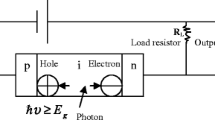Abstract
This paper deals with a relatively new SPICE model of a P-i-N photodiode. The model includes a change of velocities of electrons and holes, due to the voltage drop on the edges of the photodiode, which depends on the time form of input excitation. We have derived the model of the P-i-N photodiode for digital input excitation i.e. for Heaviside’s square wave time excitation. The model is incorporated in SPICE program and simulated with it. The model and the limitations of the model itself are observed. The output results are compared with the similar ones. It is suggested when it is practical to use the model, and determined the photodiode working domain regime when the model gives accurate results.











Similar content being viewed by others
References
W. Chen, S. Liu, IEEE Journal of Quantum Electronics, vol. 32, no. 12, pp. 2105, (1996)
J. Jou, C. Liu, C. Hsiao, H. Lin and Hsiu-Chih Lee, IEEE Photonic Technology Letters, vol. 14, no. 4, pp. 525, (2002)
Y. Batawy, J. Deen, Journal of Lightwave Technology, vol. 23, no. 1, pp. 423, (2005)
Y. Batawy, J. Deen, and N. Das, Journal of Lightwave Technology, vol. 21, no. 9, pp. 2031, (2003)
Y. Batawy, J. Deen, IEEE Transaction on Electron Devices, vol. 52, no. 3, pp. 325, (2005)
M. Lu, J. Deng, C. Juang, M. Jou, and B. Lee, IEEE Journal of Quantum Electronics, vol. 31, no. 8, pp. 1418, (1995)
G. Rossi, R. Paoletti, and M. Meliga, IEEE/OSA Journal of Lightwave Technology, vol. 16, no. 8, pp. 1509, (1998)
B. Tsou, D. Pulfrey, IEEE Journal of Quantum Electronics, vol. 33, no. 2, pp. 246, (1997)
C. Chang, H. Fetterman, Solid-state electronics, vol. 29 no. 12, pp. 1295, (1986)
S. Malyshev, A. Chizh, Journal of Selected Topics in Quantum Electronics, vol. 10, no. 4, pp. 679, (2004)
P. Matavulj, D. Gvozdić, J. Radunović, Journal of Lightwave Technology, vol. 15, no. 12, pp. 2270, (1997)
M. Lazović, P. Matavulj and J. Radunović, Microwave and Optical Technology Letters, vol. 41, no. 6, pp. 468, (2004)
Acknowledgments
This work was supported by the Serbian Ministry of Science and Technological Development with contract No. 16001A.
Author information
Authors and Affiliations
Corresponding author
Appendix
Appendix
The diffusion current is obtained using the continuity equation for holes in N region in the case of Dirac’s time input excitation:
In above equation p n is the holes’ concentration in N region, D p is diffusion constant for holes, τ p is the holes’ life time in N region, p n0 is the thermal-equilibrium hole’s concentration in N region. Here we proposed border conditions in steady state as \( {p_n}\left( {x = {W_n} \sim d} \right) = 0 \) and \( {p_n}\left( {x = \propto } \right) = {p_{{no}}} \). This approximation is involved with the aim to simplify solving the case. Solution of the Eq. A.1 is
where γ=(1-α 2 L p 2 )/τ p , and x>d. The holes’ diffusion current in N region can be obtained as
Considering that the last member in Eq. A.2 has the biggest value, we exclude the rest members and obtain
Using the Eq. A.4 and parameter τ instead of (t-t 0 ), we obtain I pdif for the case of Heaviside’s time input excitation as
where int 01 is the intensity of Heaviside’s function. Solving the above integral we get Eq. 12.
Rights and permissions
About this article
Cite this article
Matavulj, P.S., Lazović, M.V. & Radunović, J.B. An Unique SPICE Model of Photodiode with Slowly Changeable Carriers’ Velocities. J Infrared Milli Terahz Waves 32, 64–78 (2011). https://doi.org/10.1007/s10762-010-9737-6
Received:
Accepted:
Published:
Issue Date:
DOI: https://doi.org/10.1007/s10762-010-9737-6




